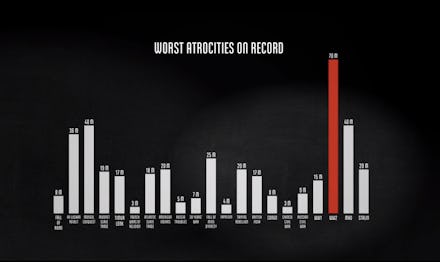One Incredible Visualization Reveals Just How Many People Died in WWII

Saturday is the 71st anniversary of D-Day, the massive Allied assault on Nazi-controlled France that helped spell the beginning of the end for Adolf Hitler's regime. Operation Overlord involved a single-day deployment of 156,000 Allied troops supported by 11,590 aircraft and 6,939 ships. According to the D-Day Museum, over the course of the next month during the Battle of Normandy, "over 425,000 Allied and German troops were killed, wounded or went missing."
But even these staggering casualties pale in comparison to the larger death toll of World War II, which was recently illustrated in a haunting visualization by documentarian Neil Halloran. In the video, there's a sense of the unthinkable sacrifice endured by soldiers and civilians from each of the war's many theaters — as well as why the world cannot afford a war on this scale again.
Halloran's visuals of all the U.S. military deaths in World War II are shown below. Each figure represents 1,000 deaths. On D-Day, approximately 2,500 American troops died, more than in the entirety of the U.S. war in Afghanistan.
Our ancestors, it seems, were made of stern stuff. During the later Battle of Okinawa, America's bloodiest single clash in the Pacific, around 12,500 Americans lost their lives.
The entire Western Front ravaged Europe, particularly Yugoslavia, which lost nearly half a million soldiers and partisans, many due to starvation, disease and mutual retaliatory mass executions.
In the battles to wrest these countries of Nazi control, the U.K. and the U.S. lost hundreds of thousands of troops.
But the vast majority of the deaths of World War II occurred on the Eastern Front, where Hitler's ill-advised invasion of the USSR initially succeeded in claiming vast swathes of Russian territory but eventually ran into utter disaster. While Russian dictator Josef Stalin's army had been greatly weakened by a series of pre-war purges that killed or imprisoned most of his most experienced commanders, he was willing to march endless columns of soldiers into desperate battle against the invaders.
One battle alone, the siege of Stalingrad, took more military lives than the entire Western Front. Hitler lost 2.3 million soldiers in the Eastern Front; Stalin lost 8.7 million. For comparison's sake, the entire pre-war population of Russia is estimated at about 110 million.
This GIF only captures a small portion of those deaths:
Here's the full comparison:
As Halloran notes, some researchers suspect the actual death toll on the Soviet side could have approached 14 million.
Count other countries that participated in WWII on the Axis side, and the death count balloons.
Then there's the civilian death toll, which includes 6 million Jews and 5 million other "undesirables" murdered by the Nazis. In concentration camps alone, 3 million Jews were killed during the Holocaust:
An additional 5 million Polish civilians died, a number dwarfed by the 10 million to 20 million Russian civilians who lost their lives. In total, there were 20 million civilian deaths in Europe, which bring the total slayings of the Western Front to over 40 million.
When deaths in the Asian theater are counted, the total death count rises to 70 million.
That number dwarfs all other atrocities on record, from the wars and mass killings that came with the decline of the Roman empire to the Atlantic slave trade and the genocide of Native Americans. As Halloran points out, World War II happened in just six years, while some of these points of comparison took course over decades or centuries. While other conflicts may have been proportionally worse to the global human population at the times they occurred, nothing comes close on an absolute scale.
The silver lining is that the number of deaths by violent conflict have declined to near-nothing by historical standards since the end of World War II. But Halloran's visualization is a stark reminder that despite Americans' memory of World War II as "the good war," the human toll of that conflict was quite unlike anything generations since have ever seen.
Some died as heroes, storming the beaches of Normandy or defending doomed cities against Axis assault. Tens of millions more were murdered in camps, died of disease or starved. Their grim stories should be remembered as fully as those of the patriots that sacrificed their lives during the biggest war in human history.
Watch the full video below: